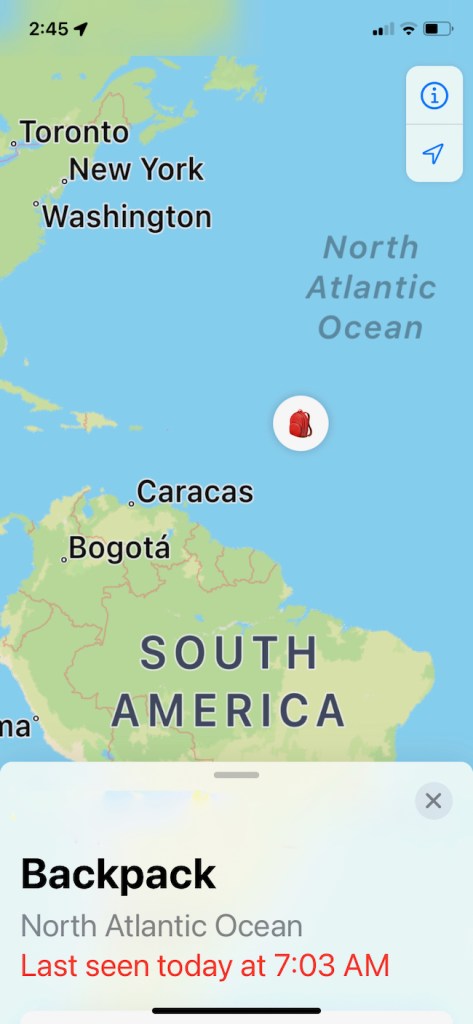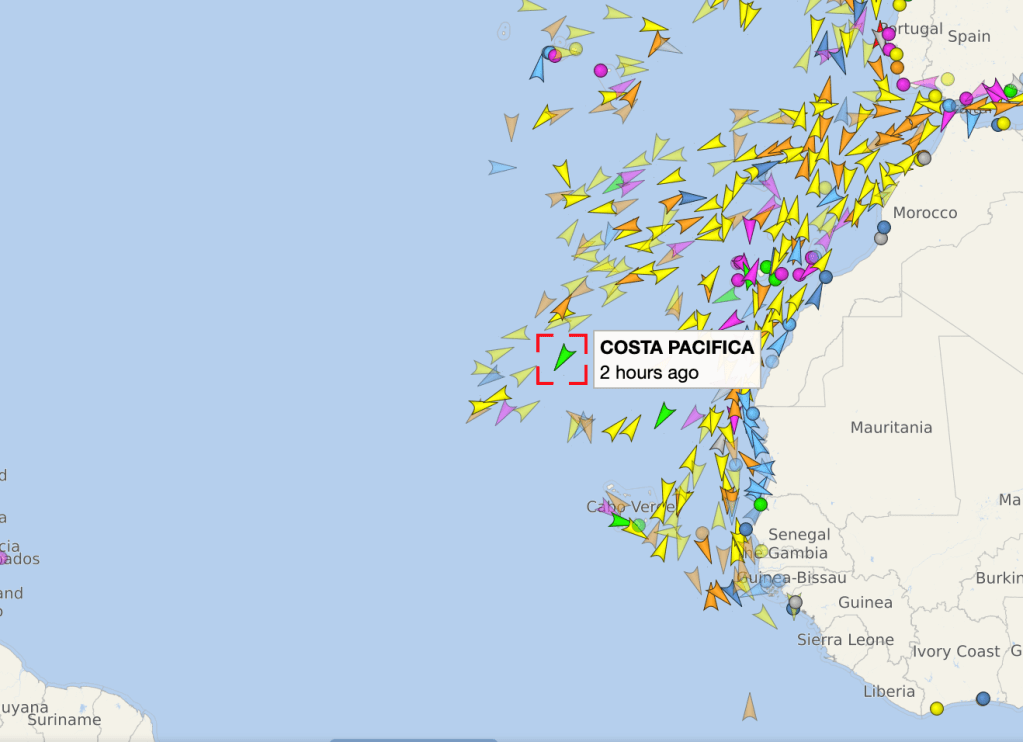Errant AirTag in Exotic Tortola

I’ve never spent any time in the Caribbean or Central or South America. As I recover from Christmas activities and transition into New Years and Mardi Gras (yes, in the South it is a Thing) my errant little AirTag is enjoying adventures I’ve never hazarded. I can only wonder where this little creature will go before I lose it completely?
Take a Wife With You
Our church has daily readings, called The Lectionary, and the one I read also features Saints of the Church, people who have served in faithfulness. Today’s reading had an impact on me for several reasons. I was immediately caught by the fact he was assigned, and told to take a wife with him, at which point he immediately proposed to a woman he thought suitable who accepted. So interesting, and so different from the way “courtships” are conducted these days. (With more reading in Wikipedia, I discovered his education was funded by donors, he was trained as a blacksmith and he actually had a fiancee, and she was the one who married him and went with him to Moose Bay. She worked with the women.)
The union was fruitful. John Horden and his wife were able to accomplish great things among the Cree and Inuit, learning their language, preaching in their tongue. It sounds like more than the preaching, his life and his love of his parishoners attracted converts to the faith.

JOHN HORDEN
MISSIONARY BISHOP IN CANADA, 1893
John Horden (1828 – January 12, 1893) was the first Anglican Bishop of Moosonee, Canada.
On May 10, 1851, he received a letter from Church Missionary Society, informing him that the bishop of Rupert’s Land had made a request for a schoolmaster at Moose Factory, in northern Ontario, and that he had been appointed to fill the position. They also told him to prepare to leave within a month, and indicated that they desired he marry and take his wife out to assist him in his missionary work. Although he was less than enthused about the appointment, he immediately prepared for his new position. He contacted the woman of his choice, a young lady who herself had missionary inclinations, and she agreed to marry him. On June 8, 1851, they set sail for Canada. Horden spent much of his time on the trip by continuing his studies of the Greek Testament and beginning the study of the Cree language.
He went among the natives, writing down new words as he heard them and, after eight month’s effort, was able to preach to the natives without an interpreter. He was ordained a priest during this period. Soon Horden had prepared a prayer book, a hymnal, and translations of the Gospels in the Cree language.
Then in 1865, Horden and his family, which now included five children that he and his wife had had in Canada, sailed back to England so that his children could be educated. Upon Horden’s return to England, he found he was very well-known throughout the British Isles, and became a popular and sought-after speaker. In 1867, Horden returned with his wife to James’ Bay.
In the autumn of 1872, Horden received a message to return to England to be consecrated as a bishop, and on December 15, 1872, he and two others were ordained in a ceremony involving eight other bishops, including Bishop Anderson, who had first ordained Horden 20 years earlier.
He continued to serve as bishop of his huge territory, making pastoral visits to as many parts of his huge diocese as possible, despite his having a serious problem with rheumatism. In his later years, he also worked diligently to finish his translation of the Bible into the Cree language.
Errant AirTag Nearing South America

I love that as I age, I am learning skills I never dreamed I would have – or want! And yet, I am glad I have learned to live with mystery, with contradictions, with ambiguity and ambivalence.
I don’t know how my AirTag left my “backpack,” which is really my duffle. I know it happened in Barcelona. Maybe I dropped it? The duffle was taken from my room with my carry-on and taken to the port where it went through inspection all on its own. It then appeared miraculously in my room aboard the Nautica. I say miraculously, because I never take anything for granted. Yes, it was supposed to show up in my room.
No, I am not so trusting as to believe it will. I’ve been without baggage too many times. So, I am just thankful when things happen as promised, and I have clothing and shoes for the trip.
I’m so glad that it really doesn’t matter to me that much that the AirTag didn’t make it with me. Its purpose is to keep track of my bag, and as long as I have the bag, the important things are covered.
What a shock it was when I was in Montreal, checking on my carry-on, which had become a checked bag in Abu Dhabi, and discovered my AirTag from the duffle is still reporting to me. It made me laugh. And now, trip over, back to the routine life of Pensacola and the unsettled month of December, it gives me a small thrill every day that I check for its location and find it in a new spot.
I am living vicariously. Although I am not in motion (nomad that I am), a part connected to me is heading off into the unknown.
The Grapevine, TX location is a mystery. I’m inclined to think it is an anomaly of some kind, but I have no clue, truly, as to why I would have a brief report it was there, and then, a short while later, it is back on the ship. The mystery continues.
Air Tag Finds a New Home in . . . Grapevine, TX ???

For a while, there was no report available on my nomadic Air Tag. I am guessing it got on a plane or – I don’t know what, because from the middle of the Atlantic, it suddenly shows up in Grapevine, Texas.
I wonder if it will travel again, or if it will settle down for the holidays and then travel? Or will it return to roaming?
I hope no one figures out how to re-program the Air Tag. I’m having to much fun checking in on it.
My Backpack Visits The Great Meteor Seamount

My little Air Tag reminds me of my days in the State Department. A friend would talk of “singing for our supper,” by which he meant our obligation to be entertaining and have a story or two to tell so people would always be glad they invited us.
My Air Tag, emancipated as it became, is certainly entertaining me, and, I hope, you. Do you have any clue what The Great Meteor Seamount is? I assumed it was the site of a fallen meteor, and evidently a huge one. Wrong. It is a sea mountain, yes, but one discovered by people on a ship called Meteor. Here is more information for you, if you, like me, like to go down a rabbit hole or two.
This is from Wickipedia:
Great Meteor Seamount
From Wikipedia, the free encyclopedia
Jump to navigationJump to search
| Great Meteor Seamount | |
|---|---|
| Great Meteor Seamount at the southern edge of the Atlantis-Meteor Seamount Complex | |
| Summit depth | 270 m (890 ft) |
| Height | 4,500 m (14,800 ft) |
| Summit area | 50×28 km² (1465 km²)[1] |
| Location | |
| Location | North Atlantic Ocean, 1,000 km (620 mi) south of the Azores |
| Coordinates |  29°57′10.6″N 28°35′31.3″WCoordinates: 29°57′10.6″N 28°35′31.3″WCoordinates:  29°57′10.6″N 28°35′31.3″W 29°57′10.6″N 28°35′31.3″W |
| Geology | |
| Type | Guyot |
| Volcanic arc/chain | Seewarte Seamounts |
| History | |
| Discovery date | 1938 |
| Discovered by | Meteor |
| Wikimedia | © OpenStreetMap | |
The Great Meteor Seamount, also called the Great Meteor Tablemount, is a guyot and the largest seamount in the North Atlantic with a volume of 24,000 km3 (5,800 cu mi). It is one of the Seewarte Seamounts, rooted on a large terrace located south of the Azores Plateau. The crust underlying Great Meteor has an age of 85 million years, deduced from the magnetic anomaly 34 (An34) at this location.[2]
The shallow and flat summit of the Great Meteor Seamount, ranging between 150 and 300 m (490 and 980 ft) below sea level, suggests that it may have emerged sometime in the past 30 million years.[3] It is covered by a 150 to 600 m (490 to 1,970 ft) thick layer of limestone, pyroclastic rocks and bioclastic sandstones.[4] Dredged basalts from the top of the eastern and southeastern flanks of the seamount have been K–Ar dated 10.7 ± 0.5 and 16.3 ± 0.4 million years old, respectively.[5] The oldest sample has been 40Ar/39Ar dated at 17 ± 0.3 million years old.[6]
Two small seamounts exist just southwest of Great Meteor and are encircled by the −3800 m bathymetric line. These are the Closs Seamount, roughly oriented NNE-SSW, with its peak at 1,400 m (4,600 ft) depth and covering an area of approximately 390 km2 (150 sq mi), and the Little Meteor Seamount, located NNE of Closs, with over 960 km2 (370 sq mi) and a flat top 400 m (1,300 ft) below sea level.
The German research vessel Meteor discovered the tablemount between 1925 and 1927. It was given the name Great Meteor Bank, a designation still used in the official GEBCO gazetteer.
Formation[edit]
The New England hotspot formed the White Mountains 124 to 100 million years ago when the North American continent was directly overhead. As the continent drifted to the west, the hotspot gradually moved offshore. On a southeasterly course, the hotspot formed Bear Seamount, the oldest in the chain, about 100 to 103 million years ago. Over the course of millions of years, it continued creating the rest of the seamounts, eventually culminating in the Nashville Seamount about 83 million years ago. As the Atlantic Ocean continued to spread, the hotspot eventually traveled further east, forming the Great Meteor Seamount where it is found today.[7] Radiometric dating of basalt from the Great Meteor Seamount has given ages of about 11 and 16 million years old, with the bulk of the seamount possibly having formed about 22 million years ago.[8]
At Sea on the Costa Pacifica
Who knew I could have so much fun with a missing Air Tag? By figuring out which ships were in which ports on the same days, and eliminating, one by one, those going in different directions, I identified the Costa Pacifica as the ship my little Air Tag is on. I am guessing it will always be a mystery as to how it got from my backpack to the Costa Pacifica, but meanwhile, it is so much fun for me to track where it is traveling – independent of me!


Living Large off the Coast of Morocco

Although I am back in Pensacola, I get a thrill checking on the status of my missing Air Tag. Today we are off the coast of Morocco 🙂







